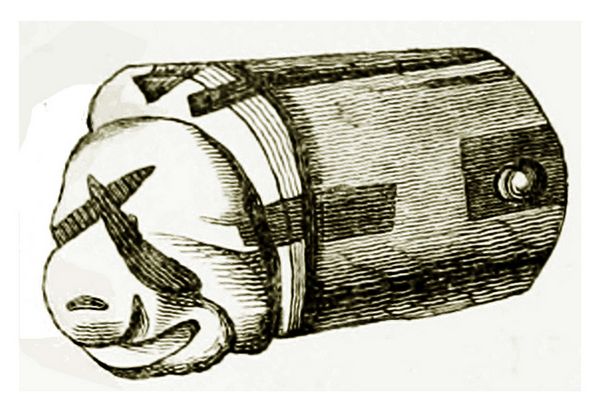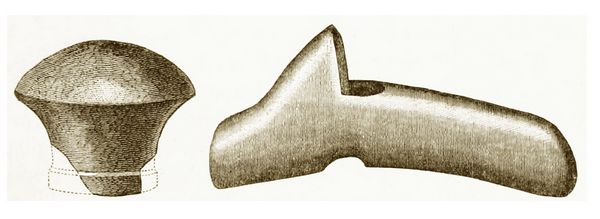|
Chapter 18 (p.259)
Pergamus of Troy, March 22nd, 1873.
During this last week we have again had constant splendid weather, and, with
150 men on an average, I have got through a good piece of work. On the
north side of the excavation on the site of the Temple of Athena, I
have already reached a depth of 26 feet, and have laid bare the Tower
in several places. The space to be dug down is now divided into four
terraces, and I am having the lowest terrace, which forms the surface
of the Tower, worked with especially great energy. As the paths are
getting both steeper and longer, the men with the wheelbarrows have now
to stop and rest half-way, so the work proceeds more slowly every day.
Still I hope that I shall bring to light the whole breadth of the Tower
in the eastern direction in three weeks, but the western side in a week
and a half. The only part of the interior of the Temple of Athena which
I have left standing is the reservoir built of large white stones
without cement, which, owing to my excavations, will in a few days be
26 feet above the Tower, and will have a very pretty appearance. It is
only by excavating the west side of that part of the Great Tower which
I uncovered last year, that I shall be able to judge in what direction
the walls run out from it, and what my next work will be.
 The most
remarkable of the objects (p.260) found this week is certainly a large
knob belonging to a stick, of the purest and finest crystal, and in the
form of a very beautifully wrought lion’s head (fig.174); it was discovered upon
the Tower at a depth of 26 feet. It must have been the ornament of a
Trojan’s staff or sceptre (s??pt???), for I found it among those
brilliant red and black fragments of pottery, which only occur at a
depth of from 36 to 46 feet, except upon the Tower.
Fig.174: A Lion-Headed Sceptre-handle of the finest crystal: found on the Tower (8m depth).
Not only this
lion’s head, but the illustrations drawn from the lion, which occur
repeatedly in the Iliad, make it seem extremely probable that in remote
antiquity lions existed in this neighbourhood. Homer could not possibly
have described so excellently the characteristics of this animal, had
he not had frequent opportunity of watching them, and his geographical
knowledge of southern countries is too slight for us to suppose that he
had visited them, and had there become intimately acquainted with the
characteristics of the lion. Not far from the lion’s head I found a
splendidly cut hexagon of the purest crystal, as well as a small
pyramid, 1½ inch long and broad, and 1-2/3 inch high, made of black,
white and blue streaked marble, such as is not found in this district;
the hole which runs through the centre of the pyramid is filled with
lead.
I
also found upon the Tower a very primitive marble idol, 7½ inches in
length, 3-1/3 inches broad, and 1-1/5 inch thick; also a very fine
copper lance; further, a large mould of mica-schist for casting twelve
different weapons and instruments, as well as a beautiful sling-bullet
made of loadstone. In the higher strata, and in fact at a depth of 4
meters (13 feet), the most curious article certainly is an idol of the
Trojan tutelary goddess made of slate, such as has never hitherto been
found. It shows the owl’s face, two breasts and a navel, and long hair
at the back of the head; (p.261) two horizontal lines on the neck, which
are joined by small cross lines, seem to denote armour. Marble idols
without the owl’s face, but otherwise of exactly the same form as those
with the owl’s face, are met with in numbers in all the strata between
3 and 8 meters deep (10 to 26 feet).
 I likewise found long, thin copper
nails with round heads at the thick end, or without heads, but with the
end bent round, which I now perceive can only be breast or hair pins,
and not actual nails for driving into wood. I find them also in
quantities in the strata of this excavation between 4 and 7 meters deep
(13 to 23 feet), and I must therefore decidedly pronounce that the
people to whom these strata of ruins belong were acquainted with copper.
Fig.175: A Mould of Mica-schist, for casting various metal Instruments (Tower, 8m depth).
A
strange instrument of copper, almost in the shape of a horse’s bit, but
with two pointed hooks, was found at a depth (p.262) of 10 feet (fig.176). Besides
this, we met with two somewhat crooked copper knives, at from 13 to 16½
feet down, as well as a small but very fine knife, in the form of a
saw, made of a shell.
 Fig.176 (left): A curious Instrument of Copper (3 m depth).
Fig.177 right): A perforated and grooved piece of Mica-schist, probably for supporting a Spit. Found on the Tower (8m depth).
Stone instruments are continually met with here
in great numbers in all of the strata between 2 and 8 meters deep (6½
to 26 feet), whereas in my excavations of 1871 and 1872 I only found
them below a depth of 13 feet. Two beautiful stone lances, one of
diorite, the other of hard green stone, were found, the one at 20 feet
down, the other at 11½ feet. During this week, I also found very many
knives of silex in the form of saws or of sharp blades, with one or two
edges; further, a very prettily cut piece of mica-schist with a
perforated hole and a groove on the upper side, which may have been
fastened to a fireplace and have served for turning a spit (fig.177).
 Fig.178: A large Terra-cotta Vase, with two large Handles and two small Handles or Rings (5m depth).
I
have observed that the terra-cottas here generally (p.263) occur in great
numbers only in and below those strata of débris which are mixed with
enormous quantities of small shells, and which usually commence at a
depth of 13 feet, but sometimes not till 20 feet. However, every now
and then we come upon beautiful terra-cottas above these shell strata;
and thus, for instance, in the great cutting, directly in front of my
door, we found, at a depth of 10 feet, several large and splendid
vessels, among which was an extremely elegant black vase, in the shape
of a soup-tureen, and at a depth of 11½ feet two mixing-bowls, the
smaller one of which has two, the larger one four, handles; the larger
mixing-bowl is two feet high, and its orifice is as much in diameter.
(See Cut, No. 41, p. 74.) At a depth of 16½ feet I found an extremely
curious large vase, which has two large handles at the top and two
small ones at the sides (fig.178). Various other vases of extremely curious forms
were discovered at a depth of from 13 to 26 feet; of them I will only
mention one large brilliant black vase with two female breasts and two
handles, by the side of which are the stumps of the upraised arms which
ornamented this vessel. The upper part of it, which, as is proved by
the arms and breasts, was ornamented with the owl’s head of the Ilian
Athena, is unfortunately wanting. It is strange that this vase has no
navel.
Of the large and brilliant red goblets in the form of
huge champagne-glasses, with two immense handles, we met with many in a
more or less broken condition at a depth of from 6 to 8 meters (20 to
26 feet); among them is an enormous goblet 15¾ inches long, of which I
have been able to collect all the fragments and shall therefore be able
to restore it. (See No. 112, p. 158.)
I found, at a depth of
from 23 to 26 feet, quantities of earthen plates, some of which are of
a brilliant red colour, but most of them are uncoloured. At a depth of
20 feet I found a fragment of pottery with a cross, at the four ends of
which are dots, which can only indicate the (p.264) nails by means of
which it was fastened. Small terra-cotta whorls, with Aryan religious
symbols, were again found in great numbers; several of them have
decorations not hitherto met with. Of terra-cotta balls we have found
three during these last days, two of them are very remarkable. One
hemisphere of the first has nineteen figures like the Greek letter Rho
(?) in a circle round it, and ten of the same figures in a line through
the middle point, also a number of little stars; the other hemisphere
is entirely filled with little stars (fig.179). The second ball has a half moon
on the one hemisphere and large stars on the other.

No. 179. A remarkable Terra-cotta Ball (6 m depth).
 No. 180. A finely engraved Ivory Tube, probably part of a Flute. Found on the Tower (8 M.).
Among
the remarkable objects found during the week, I must also mention a
splendidly ornamented piece of ivory, from a depth of 8 meters (26
feet), which is almost the shape of a flute, and may have been used as
such (fig.180); further, a flat bone, which has one hole at the one end and three
at the other, and seems certainly to have belonged to a musical
instrument.
I sometimes find here house-walls built of stones
joined with mere earth, which must certainly have been erected long
before the Greek settlement, but which rise to within a meter (3¼ feet)
of the surface; in fact in the (p.265) great cutting in front of my house,
I have pierced through two such walls 6½ feet thick, which here formed
the corner of a house, and which reach up to within a foot of the
surface; they appear to extend pretty far down, and in my next letter I
shall be able to give more details about them.
 Fig.181 (left): Knob for a Stick, of fine marble (3m depth).
Fig.182 (right): Bone handle of a Trojan’s Staff or Sceptre (7m depth.).[236]
Although the
Pergamus, whose depths I have been ransacking, borders directly upon
the marshes formed by the Simoïs, in which there are always hundreds of
storks, yet none of them ever settle down here. Upon one of my wooden
houses and upon the stone one I had two comfortable nests made for
them, but although there are sometimes twelve storks’ nests upon one
roof in some of the surrounding Turkish villages, yet none will settle
on mine; it is probably too cold and stormy for the little storks on
“????? ??eµ?essa.”
Footnotes:
[149]
Some
[Continue to Chapter 19]
[Return to Table of Contents]
|
|